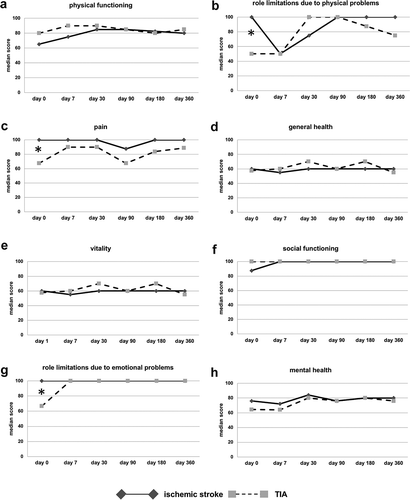Figures & data
Table 1. Patient characteristics
Figure 1. Anxiety and depression in TIA and ischemic stroke patients over time. Emotional symptoms were assessed in both groups using the Hospital Anxiety and Depression Scale (HADS). Data are given as median ± interquartile range as represented by boxes. Whiskers indicate for maximum and minimum score. *: p < 0.003 (adjusted for multiple comparison with Bonferroni correction), lines with asterisk (*) indicate statistically significant changes) between d0 or d7 and later time points in either ischemic stroke population (black) or TIA group (light grey). #: p < 0.05, black line with hash (#) indicate for statistically significant results in the inter-group comparison. Sample sizes for ischemic stroke and TIA varied between individual assessment sessions due to patients lost to follow-up and ranged from n = 65 to n = 73 for stroke and n = 18 to n = 23 for TIA

Figure 2. Different dimensions of quality of life in ischemic stroke and TIA patients over time. Quality of life was measured by the SF-36 questionnaire, which allows assessing eight dimensions of quality of live. Median scores and their shift over time are illustrated in the graphics for each subscale of SF-36. Results for the ischemic stroke group are given as continuous lines with dark grey diamonds, whereas the results for the TIA group are shown in dashed lines with light grey squares. Significant differences between the two subgroups are indicated by asterisk (*). Sample sizes varied from n = 82 to n = 95 between individual assessment sessions (n = 64 to n = 73 for ischemic stroke patients; n = 18 to n = 23 for TIA patients) due to patients lost to follow-up

Figure 3. Quality of life as well as anxiety and depression in ischemic stroke and TIA patients in comparison to the general population at d360. Sum scores were calculated for SF-36 and HADS to compare individual quality of live and emotional symptoms with data from a representative general population sample cohort. To compare long-term affection as measured by both questionnaires, data from d360 was assessed. Means are given for ischemic stroke patients in dark, TIA patients in light and the general population in medium grey

Table 2. A – Correlation matrix of emotional symptoms and quality of life in patients with ischemic stroke one year after the qualifying event. B – Correlation matrix of emotional symptoms and quality of life in patients with TIA one year after the qualifying event
